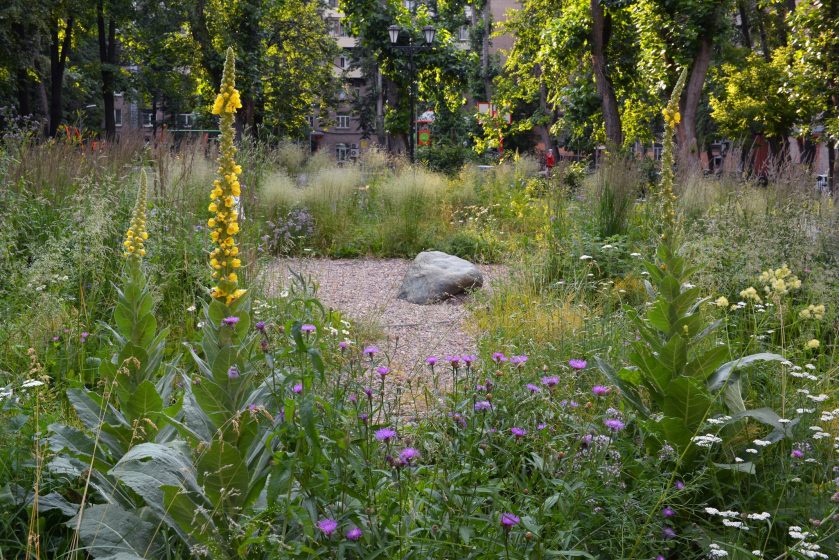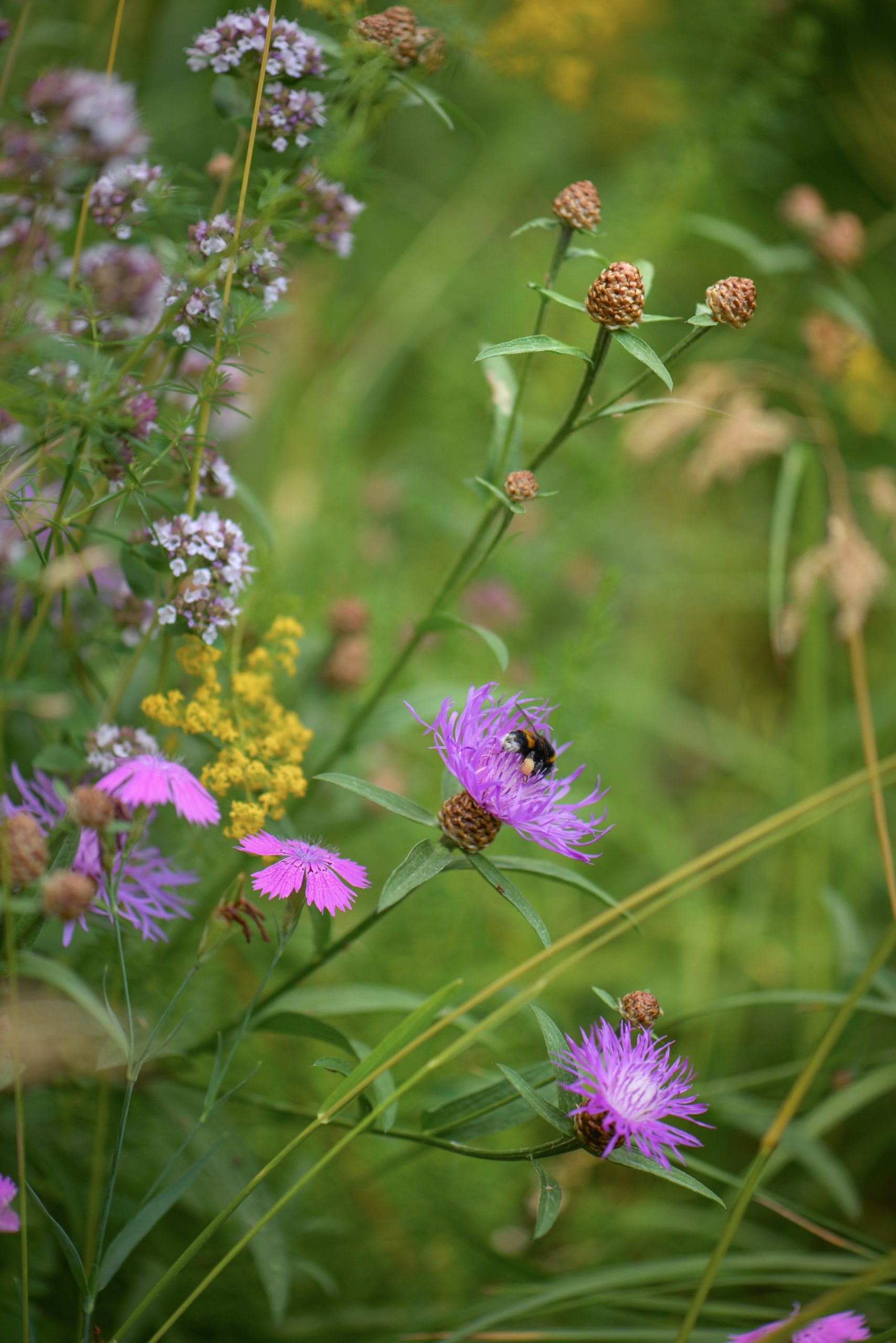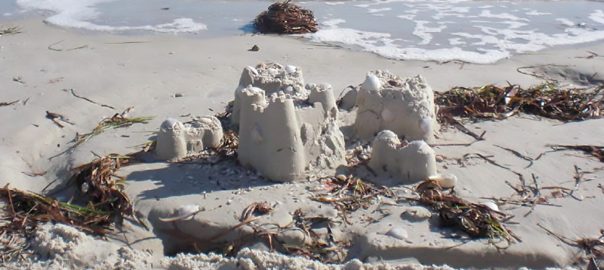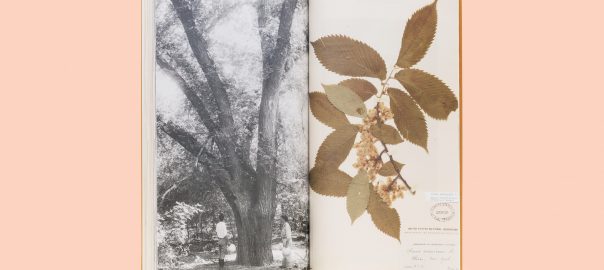In Russia, few home gardeners use native species and they are not available in nurseries. In creating Recollections of the Meadow, we hoped to test-run the approach where native plant species would be used to build a flower bed, and we intended to share the resulting algorithm with everyone willing to follow suit.
Last year in spring, we came up with an idea of creating a flower garden that would only feature native plant species. Why is that both difficult and important? And what conclusions can we draw after a full year of watching the flower garden grow and seeing how both community and specialists respond to it?
Plants and pollinators have been evolving together for millions of years and depend on each other. For example, Moscow is home to the red bartsia bee (Melitta tricincta) which only visits red bartsia. And the small tortoiseshell caterpillar feeds almost exclusively on common nettle, a stinging plant considered a weed.
But the share of indigenous plants in the cities has been decreasing across Europe, and that has been dragging along insect and even bird biodiversity. Over the last 150 years and by the end of the 20th century, the share of indigenous species in European flora decreased from 88% to 68% (Kent, 1975). The majority of the deleted species, 27%, belonged to meadow communities. Meanwhile, the share of alien species has been on the increase. Popular in landscape gardening, they “escape” their cultured environments and invade local communities displacing wild species. Lupin (Lupinus polyphyllus) and Canadian goldenrod (Solidago canadensis) have already made it among Russia’s top 100 most dangerous invasives occupying huge territories of natural ecosystems, while 7 species of Moscow’s native and very common bellflower have already been listed as threatened (Red List).
One can speculate about the need to promote “proper” landscape gardening and use only native plant species that can support pollinators. Let’s actually do it. What would we have to face? Last year in spring, our “Architects of the Meadow” team which consists of landscape architects and biologists took the chance to recreate a meadow with wild grasses in an ordinary Moscow yard, so that it could both compete with other flower gardens in beauty and stand out significantly in terms of how it “benefits” wildlife. We wanted to make a point that, in Russia, native species were undeservedly forgotten and raise this awareness among both professionals and local residents.
A month ago, our “Recollections of the Meadow” was awarded a prize by Moscow Urban Forum, Russia’s main architectural forum—the flower garden was put up for voting by an independent jury, and the winner was determined by Moscow residents in a month-long voting session at the main city website. But the road to victory and attention was bumpy.



No planting material in plant nurseries
Before starting the work, we made a list of 46 plant species that we would like to grow in our flower bed and divided them into 5 groups—to be planted in blocks, to form the core of the flower garden, to create a structure, to support the middle layer, and early bloomers to decorate the flower bed in early spring. This way, our garden would turn out diverse and as attractive as possible in every season of the year. Eventually, plant nurseries could only provide a third of the list, which meant 14 plant species. But we decided to go ahead with what we managed to find while asking local residents to bring those species from our list that grew on their own on their countryside plots. They are still common in the countryside, whereas in the cities, trimmed lawn prevalence has already made them a rare find.
Native plants are not easily found for sale in Russia. Landscape nurseries hardly ever grow them as there is no customer demand, while consumers do not want to pay for something that is perceived as a weed, is mown off, and grows for free. As a result, even landscape gardening specialists—landscape architects—have little knowledge of the local flora, the names of those plants, and their bloom potential. So, it turns out there is no one—neither a customer nor a contractor—to initiate planting a native flower in a flower bed.
Professionals surprised by plant “character traits” in a flower bed
Working with native species was a professional challenge for landscape architects who were responsible for drafting the flower garden concept. The way plants would behave in a flower bed could mostly be imagined in theory only — knowing how they bloom and grow in the wild is one thing and having them in a closed area of a flower bed is quite another. Eventually, we were in for both pleasant and unpleasant surprises. For example, field bindweed (Convolvulus arvensis) grew so big that it even tipped some of the other plants to the side by twining around them. On the other hand, common mullein (Verbascum thapsus) was so grateful for fertilized soil that, instead of being predictably noticeable, it grew incredibly gigantic and could not but be a real pleasure for the eye.
Constant need to educate local residents
From the very beginning, we decided to build the flower bed in a community where locals would support the idea and be ready to tend the flower garden on their own. As this is a volunteer project for us and many team members live far from where the flower bed was built, we knew we would not be able to either water it every day while the plants take root or ensure other types of regular care. Eventually, we did right by relying on the community. More than 50 people helped us plant the flower bed (which is no less than 200 square meters big!), more than 100 people participated in the crowdfunding efforts to finance its creation, and the garden was regularly watered throughout the hot summer. We started a chat that was joined by the most active gardeners. It seemed that everyone was on the same page exchanging photos of the blooming plants while in the chat and pie recipes while around the flower bed. But then winter was over, spring was late, and it became clear that not many residents understand and, most importantly, accept the natural concept of their yard’s central flower garden. Plant nurseries did not have early bloomers in stock, so our mini garden did not have them either, and after the snow melted, it was first russet, and then bright yellow dandelion heads started covering it—either their seeds had been brought by the wind or their roots had been left intact. And Moscow residents associate dandelions with the most aggressive weeds—that is, if you are fond of even lawns.
So, despite our belief that this yellow-colored meadow was pretty, discussions started sprawling across community chats suggesting the flower bed needed other flowers as the existing ones were not decent enough. We understood that a one-off educational session on the mini garden’s natural concept was not enough and that regular educational activities had to be included in such projects. When offered an explanation of why this very type of flower garden has been created and what its benefits and advantages are, former critics embraced the idea. And knowing the exact months when the plants in the flower bed are going to blossom—and that they simply need some time—makes other opponents come to terms with it too.
As a result, discussions about the lack of decorative value in our flower garden had subsided by early June when many garden’s plants reappeared and began blossoming in all their natural glory. July, in its turn, would be a downright fabulous time to endlessly enjoy the garden’s colors.

When creating Recollections of the Meadow, we hoped to test-run the approach where native plant species would be used to build a flower bed, and we intended to share the resulting algorithm with everyone willing to follow suit—featuring places where flowers can be found and ways to plant them to get a beautiful and useful result. But we have to admit it turned out we still haven’t a ready and simple scheme for doing this, even though a lot of Moscow residents who care about nature would like to implement a similar project in their yards. One cannot foresee what choice plant nurseries will be able to offer (especially given the low demand for native species) and what the soil or lighting of the plot will be like, meaning that each similar project will be individual and labor-intensive—and consequently, poorly scalable. On the bright side, people’s eagerness is scalable, judging by the interest our project sparked in social and mass media, by the feedback from people seeking advice or help, and eventually, by the prize we received. And that means one day the plants native to the city will be able to return there as “residents” in their own right.
Nadezhda Kiyatkina
Moscow






Leave a Reply